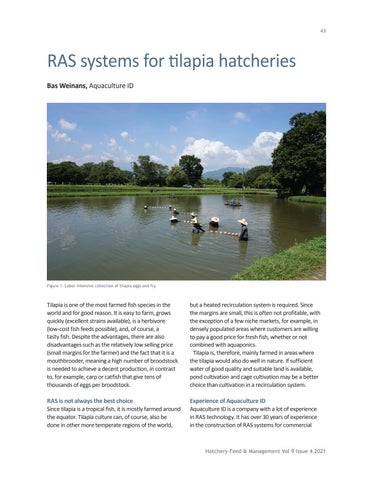43
RAS systems for tilapia hatcheries Bas Weinans, Aquaculture ID
Figure 1. Labor-intensive collection of tilapia eggs and fry.
Tilapia is one of the most farmed fish species in the world and for good reason. It is easy to farm, grows quickly (excellent strains available), is a herbivore (low-cost fish feeds possible), and, of course, a tasty fish. Despite the advantages, there are also disadvantages such as the relatively low selling price (small margins for the farmer) and the fact that it is a mouthbrooder, meaning a high number of broodstock is needed to achieve a decent production, in contrast to, for example, carp or catfish that give tens of thousands of eggs per broodstock.
but a heated recirculation system is required. Since the margins are small, this is often not profitable, with the exception of a few niche markets, for example, in densely populated areas where customers are willing to pay a good price for fresh fish, whether or not combined with aquaponics. Tilapia is, therefore, mainly farmed in areas where the tilapia would also do well in nature. If sufficient water of good quality and suitable land is available, pond cultivation and cage cultivation may be a better choice than cultivation in a recirculation system.
RAS is not always the best choice Since tilapia is a tropical fish, it is mostly farmed around the equator. Tilapia culture can, of course, also be done in other more temperate regions of the world,
Experience of Aquaculture ID Aquaculture ID is a company with a lot of experience in RAS technology. It has over 30 years of experience in the construction of RAS systems for commercial
Hatchery Feed & Management Vol 9 Issue 4 2021










